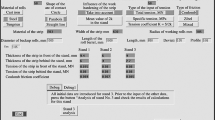Results are given for a study of rolling plate metal by technology including rolling in grooved rolls and levelling on a smooth barrel. Results of computer modeling and analysis of the Lode–Nadai coefficient show that during rolling in grooved rolls two types of deformation-compression arise in a billet cross section, i.e., compression in inclined areas and shear in ridged zones. This picture of stress distribution is most favorable since compressive strain leads to “healing” of possible metal discontinuities, but shear deformation leads to intense working of the original metal structure. During rolling in the first pair of smooth rolls deformation compressive in nature predominates, and in the second pair of rolls it is deformation alternating in nature. In any billet vertical section, metal contact with rolls occurs on both surfaces, i.e., upper and lower, which leads to compression in ridge zones, but to tension in inclined sections. Analysis of the results of metallographic studies points to the benefits for rolling in grooved rolls in the plan of preparing a metal fine-grained isotropic structure. The use of grooved rolls leads to significant strengthening of L63 brass compared with using smooth rolls with an identical overall degree of deformation.








Similar content being viewed by others
References
E. G. Pashinskaya and A. V. Zavdoveev, “Use of rolling with shear and traditional drawing for forming the structure and properties of low-carbon steels,” Fiz. Tekhn. Vysok. Temp., 22, No. 3, 113–123 (2012).
A. I. Traino and V. P. Polukhin, “Rolled sheet manufacture using local deformation,” Proizv. Prokata, No. 1, 25–31 (2011).
A. V. Brinza, V. P. Polukhin, V. V. Brinza, et al., USSR Inventor’s Cert. 1088818, IPC3 В21В1/22, “Rolling method,” subm. 05.20.1983, publ. 04.30.1984.
A. B. Naizabekov and S. N. Lezhnev, Kazakhstan Republic Patent 14791, IPC В21В27/02, “Rolls for rolling thick sheets,” subm. 03.06.2003, publ. 11.15.2003, Byull., No. 11.
A. Naizabekov, S. Lezhnev, T. Koinov, et al., “Research and development of technology for rolling of high-quality plates of non-ferrous metals and alloys in relief rolls,” J. Chem. Technol. Metallurgy, 51, No. 4, 363–370 (2016).
V. M. Segal, V. I. Reznikov, V. I. Kopylov, et al., Metal Plastic Structure Formation Processes, Nauka i Tekhnika, Kiev (1994).
Author information
Authors and Affiliations
Corresponding author
Additional information
Translated from Metallurg, No. 5, pp. 63–69, May, 2017.
Rights and permissions
About this article
Cite this article
Naizabekov, A.B., Lezhnev, S.N., Panin, E.A. et al. Alternating Sign Rolling Technology in Grooved Rolls for Nonferrous Metal Plate Billets. Metallurgist 61, 406–413 (2017). https://doi.org/10.1007/s11015-017-0508-7
Received:
Published:
Issue Date:
DOI: https://doi.org/10.1007/s11015-017-0508-7




